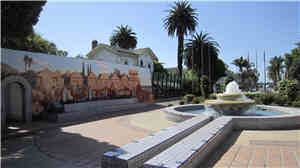"Location, location, location", "Time is Money", "Find a Need and Fill It", these three time honored maxims of business are no less true in today's environment of oil insecurity and catastrophic economic risk; in fact, they are all the more so.
Of course, one might argue that the internet makes location less of an issue, but truly, it proves the point that getting the things you want quickly, in an automated way, with minimum hassle, is what makes the internet so valuable, and yet, there are some things that simply cannot move along the information highway.
As oil prices rise, any business with a physical product must consider the cost of moving raw materials to their factory and moving finished goods into the hands of customers. Any storefront service must consider the customer's cost of traveling to the business location and recognize how much harder the oil crisis is making it for consumers to get around. Many businesses do well on the world wide web because internet reduces travel costs, but for any business with a physical product or a service direct to the customer, there is a need for some form of transportation.
The next revolution is in reducing the cost of physical movement.
Furthermore, the national movement towards Do Not Call laws, the saturation of traditional forms of advertising, the high cost of TV advertising, and ever more ad-weary public ensure that the ever-changing science of finding new customers is finding new challenges every year. Now that the internet has skimmed so much foot traffic from traditional retail locations, anything that reduces obstacles or provides an attraction for customers is crucial to success.
It's obvious that the most valuable retail space is where the customers congregate, in malls, and in busy pedestrian areas. It's also well known that non-retail businesses, and industries do well to choose facilities in proximity to valuable resources, partners, and personnel.
Time is money; for the consumer as well as the business, there is a direct trade-off between cost and convenience. This is precisely why people are willing to pay so much more to buy groceries at a convenience store, and why so few people care that fast food is unpalatable and bad for your health.
Convenience is king.
According to The Center for Transit Excellence, "America's families spend more than 19 cents out of every dollar earned on transportation, an expense second only to housing and greater than food and health care combined." and "The poorest quintile of American households spend 36% of their budgets on transportation, while the richest fifth spend only 14%. "
If time is money for the average American, it's all the more so for busy executives.
"Almost half of all Fortune 500 companies, representing over $2 trillion in annual revenue, are headquartered in America's transit-intensive metropolitan areas. Drivers in one-third of U.S. cities spend more than 40 hours a year (an entire work week) in traffic that is not moving."
It's easy to pick on cars; to capitalize on the natural love/hate relationship that develops any time you depend on something as much as we depend on cars. Never mind the effect of fuel emissions on our quality of life or the social and economic costs of reliance on fossil fuel. According to Wikipedia, transportation is the highest sector of oil use, "accounting for approximately 68.9% of the oil used in the United States in 2006,[19] and 55% of oil use worldwide as documented in the Hirsch report. "
But what can any of us do about it? In a free market economy decisions are made on an individual level; for an alternative to succeed it must satisfy the needs of the individual.
Many people have taken to their bikes for the cheap on-demand convenience and the simple pleasure of riding, as well as for the health benefits. Bikes are great for young, healthy, individuals, with no kids in tow and not much to carry. Bikes are certainly fast and fuel efficient, but not much good for the elderly, people in cold climes, cumbersome cargo, or those with a need to change clothes when they get to their destination, and they're also very unsafe when they have to compete with cars on the roadways.
Public transportation is also a great idea, unless you're in a hurry, and who isn't? One of the biggest problems with public transportation, worse even than having to conform to the schedule of the mode you've chosen, or having to mix with the unwashed masses, is what the industry refers to as the problem of "the last mile", the problem of getting from the closest stop or station to your actual destination.
The problem of the last mile is actually related to the problem of getting in front of your customers and getting your customers to your door. Those businesses that can effectively solve the problem of the last mile for their customers, are the ones that will succeed in the new marketplace.
Keep in mind that the bigger your parking lot, the further your store is from the street. Also, the bigger the street, the harder it is to cross and the less attractive to pedestrian traffic. Some stores, especially grocery stores now provide shuttle service to help people without cars get home with their groceries. Many stores and employers in the city have parking problems so serious that they actually impact business and the problem is getting worse. The more we widen streets and freeways, the more we push out buildings and usable land to where we need more and wider streets and freeways to get to any of it.
So, is it possible to fill this need we've identified? Is there something that can move people and goods quickly, efficiently, and profitably? If we were to design such a thing, what would it look like?
One likely candidate is PRT, Private Rapid Transit.
PRT is a system of automated, interconnected micro-rail units. If you've ever ridden a roller coaster, you've already tried micro-rail. It's fun, very fast and surprisingly safe*. PRT applies the general technology of roller coasters to what some call "horizontal elevators", a transit system where you get in, tell the console where you want to go, and the doors open automatically when you arrive.
Unfortunately the closest examples of PRT today are a far cry from the service envisioned by most PRT enthusiasts. There's the system in Mogantown West Virginia, which has been running for over thirty five years with no accidents and "on-time service rates far surpassing the bus services it replaced". We also have several airport shuttle services, including the newly built system at Heathrow and one for the city of Abu Dhabi . But none of these really fulfill the promise of PRT. These are the Commodore 64s of the new era of transit.
Before we get too far lets examine the benefits of rail. Rail is much more fuel efficient than automobiles; moving a ton of freight at 436 miles per gallon. Unfortunately when you're moving people by heavy or "light" rail, you're ratio of vehicle to cargo weight really burdens the efficiency, though it's still many times more efficient than cars. Micro-rail minimizes this effect by using much smaller vehicles and placing the propulsion in the track.
Rail is also much safer than autonomous vehicles because the cars can only go where they're allowed to. Unfortunately with heavy or "light" rail, things are much safer for the passengers, and much less safe for the people outside the train, and since it's very difficult to stop a big heavy train with all that momentum, any small misstep means a big mess. Also, heavy and light rail require operator control, and the 1800's technology isn't easy to retrofit with modern safety equipment. So micro-rail is certainly many times safer than classic rail.
Many PRT designs incorporate overhead rail which eliminates conflicts with other forms of traffic, making PRT even safer, and faster, while reducing right-of-way costs and concerns.
For PRT, the main benefit of rail is that it allows for driverless, automated control, which means passengers can relax and do other things, while the control system determines the fastest, most efficient route with simultaneous consideration of every vehicle's destination.
The true promise of PRT is in the automation, and in using small cars that take passengers to a wide array of stations without stops in between. Starting with quick stops at first, such as out to the edge of a parking lot, around a business or civic campus, or a quick hop across the street, PRT enthusiasts look forward to a day when the smaller systems grow and meet up, creating vast PRT networks that can take riders further and further, with much less physical infrastructure than traditional trains or even cars. Since PRT cars don't have on-board engines, they're much lighter than cars and can use much smaller, lighter pathways that can get you closer to where you want to go. For old-world cities originally built for pedestrians, this feature is gold!
The benefits of PRT automation are astronomical. Probably the most important is the ability to adjust to changing needs, and the ability to charge customers by cash, card or membership (such as fleet or promotional service), as well as providing a mechanism for paying individual track owners for the use of their units. Perhaps the attribute of automation that's most attractive to many and repulsive to some is the loss of paid drivers and union concerns. The ability to move people and cargo without the requirement of a licensed driver for each trip means kids, old folks and handicapped can take PRT as easily as a bus, and they won't have to sit next to a scary stranger to do it.
Those of us who have been visited by the dream of PRT talk about the profit potential, saving the environment, the insanity of reliance on foreign oil, and a desire for a less costly and intrusive infrastructure, but we're all really just impatient shoppers and business people, driven by the desire to get where we're going quickly and easily, with less cost and concern. If we can also save the planet and make money doing it, all the better.
* If roller coasters were designed as transit rather than as thill rides, they'd be safer yet.
For more information on the companies pioneering PRT see:
Jpods Hanging PRT design
Unimodal Skytran Hanging PRT design
ULTraPRT Overtrack PRT design
Vectus Overtrack PRT design
Skycab Overtrack PRT design
PRT-Consulting, Inc. Independent PRT Experts
Advanced Transit Association An American PRT Advocacy Group
Podcar City A European PRT Advocacy Group
Hermes Network Simulator Simulates boarding time and pod car movement within a network
Washington University's list of PRT technologies
Please mail your comments, questions and concerns about this article to Mina@Novotopia.com.




